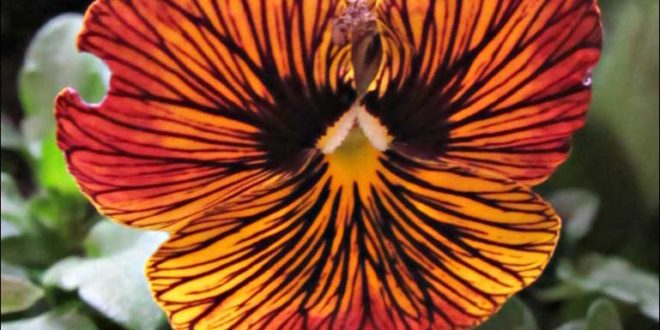“Tiger Eyes” is a new viola for 2017. 1” bright golden yellow flowers have black perfectly clear radiating veins around a central black eye. 6”-8” tall and 10” spread. Very Fragrant. I got them this year for Marie for Valentine’s Day.
The Viola genus of flowering plants is in the violet family Violaceae. It is the largest genus in the family, containing between 525 and 600 species. Most species are found in the temperate Northern Hemisphere; however, some are also found in widely divergent areas such as Hawaii, Australasia, and the Andes.
Some Viola species are perennial plants, some are annual plants, and a few are small shrubs. A large number of species, varieties and cultivars are grown in gardens for their ornamental flowers.
In horticulture the term “pansy” is normally used for those multi-coloured, large-flowered cultivars which are raised annually or biennially from seed and used extensively in bedding.
The terms “viola” and “violet” are normally reserved for small-flowered annuals or perennials, including the species.
Hardy in U.S. Department of Agriculture plant hardiness zones 3 through 9, violas and pansies are a colorful addition to your home when grown as a houseplant.
Planting
Pansies do best when you grow them in nutrient-rich, well-draining potting mix. Fill containers that are 9 to 12 inches deep with sandy loam soil that is amended with 2 to 4 inches of organic matter, like manure or peat moss. Lightly water the starter plants before planting. Water the pansies again once they are in the pots to replace any lost moisture. Lightly spread the roots of your pansies and press them firmly into the soil, pushing the potting mix up to the bottom stem of your plants. Place your planted pansies near a window that receives direct sun throughout the day.
Care
Pansies need regular water or they will fail to thrive. Test the moisture of your soil two to three times a week with a moisture meter — a device with a long metal probe you insert into soil that gives you a readout of water levels — or with your finger. When the soil is dry, give your pansies 1 inch of water, making sure to remove any standing water from under the pot. Fertilize your pansies by applying 3 tablespoons of a 5-10-5 fertilizer per pot in late fall and then again in March. When flowers are in bloom, apply fertilizer once every three to four weeks to get larger, longer-lasting flowers. Always read the label as application rates and instructions vary by brand. Prune away flowers as they wilt and you will extend blooming and get more flowers throughout the growing season.
Containers
Pansies will grow in any container that holds soil and allows water to drain. You may want to grow your pansies in small terra cotta pots and group them together on a table. You can also plant pansies in a hanging basket placed near a window. Nontraditional containers, like galvanized buckets, decorative bowls or fish bowls, can add a creative flair to your pansy display. To use a nontraditional container, first plant your pansies in a pot with drainage holes. Place the pot into your container and bury it in soil. This helps prevent overly wet soil in the pot.
Source: Annie’s Annuals
Nursery: Yamagami in Cupertino








